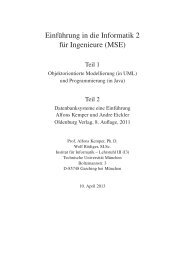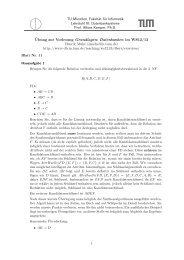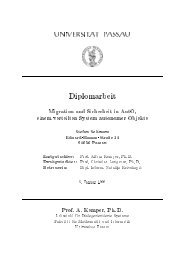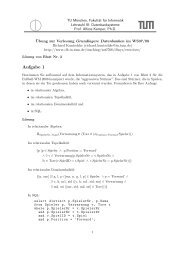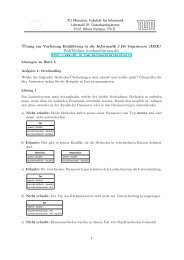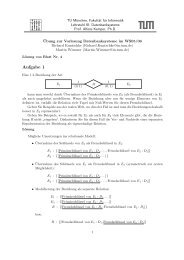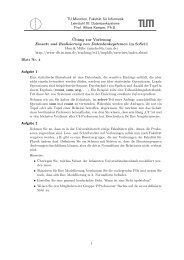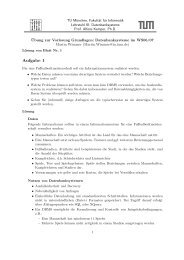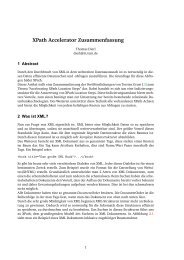The Adaptive Radix Tree: ARTful Indexing for Main-Memory ...
The Adaptive Radix Tree: ARTful Indexing for Main-Memory ...
The Adaptive Radix Tree: ARTful Indexing for Main-Memory ...
You also want an ePaper? Increase the reach of your titles
YUMPU automatically turns print PDFs into web optimized ePapers that Google loves.
are equal, a negative value if the first non-equal value of the<br />
first vector is less than the corresponding byte of the second<br />
vector, and otherwise a positive value.<br />
For finite domains, it is always possible to trans<strong>for</strong>m the values<br />
of any strictly totally ordered domain to binary-comparable<br />
keys: Each value of a domain size n is mapped to a string of<br />
⌈log 2 n⌉ bits storing the zero-extended rank minus one.<br />
B. Trans<strong>for</strong>mations<br />
We now discuss how common data types can be trans<strong>for</strong>med<br />
to binary-comparable keys.<br />
a) Unsigned Integers: <strong>The</strong> binary representation of unsigned<br />
integers already has the desired order. However, the<br />
endianness of the machine must be taken into account when<br />
storing the value into main memory. On little endian machines,<br />
the byte order must be swapped to ensure that the result is<br />
ordered from most to least significant byte.<br />
b) Signed Integers: Signed two-complement integers<br />
must be reordered because negative integers are ordered descending<br />
and are greater than the positive values. An b bit<br />
integer x is trans<strong>for</strong>med very efficiently by flipping the sign<br />
bit (using x XOR 2 b−1 ). <strong>The</strong> resulting value is then stored like<br />
an unsigned value.<br />
c) IEEE 754 Floating Point Numbers: For floating point<br />
values, the trans<strong>for</strong>mation is more involved, although conceptually<br />
not difficult. Each value is first classified as positive<br />
or negative, and as normalized number, denormalized number,<br />
NaN, ∞, or 0. Because these 10 classes do not overlap, a new<br />
rank can easily be computed and then stored like an unsigned<br />
value. One key trans<strong>for</strong>mation requires 3 if statements, 1<br />
integer multiplication, and 2 additions.<br />
d) Character Strings: <strong>The</strong> Unicode Collation Algorithm<br />
(UCA) defines complex rules <strong>for</strong> comparing Unicode strings.<br />
<strong>The</strong>re are open source libraries which implement this algorithm<br />
and which offer functions to trans<strong>for</strong>m Unicode strings<br />
to binary-comparable keys 2 . In general, it is important that<br />
each string is terminated with a value which does not appear<br />
anywhere else in any string (e.g., the 0 byte). <strong>The</strong> reason is<br />
that keys must not be prefixes of other keys.<br />
e) Null: To make a null value binary comparable, it must<br />
be assigned a value with some particular rank. For most data<br />
types, all possible values are already used. A simple solution<br />
is to increase the key length of all values by one to obtain<br />
space <strong>for</strong> the null value, e.g., 4 byte integers become 5 bytes<br />
long. A more efficient way to accommodate the null value is<br />
to increase the length only <strong>for</strong> some values of the domain. For<br />
example, assuming null should be less than all other 4 byte<br />
integers, null can be mapped to the byte sequence 0,0,0,0,0,<br />
the previously smallest value 0 is mapped to 0,0,0,0,1, and all<br />
other values retain their 4 byte representation.<br />
f) Compound Keys: Keys consisting of multiple attributes<br />
are easily handled by trans<strong>for</strong>ming each attribute separately<br />
and concatenating the results.<br />
2 <strong>The</strong> C/C++ library “International Components <strong>for</strong> Unicode”<br />
(http://site.icu-project.org/), <strong>for</strong> example, provides the ucol_getSortKey<br />
function <strong>for</strong> this purpose.<br />
V. EVALUATION<br />
In this section, we experimentally evaluate ART and compare<br />
its per<strong>for</strong>mance to alternative in-memory data structures,<br />
including comparison-based trees, hashing, and radix trees.<br />
<strong>The</strong> evaluation has two parts: First, we per<strong>for</strong>m a number of<br />
micro benchmarks, implemented as standalone programs, with<br />
all evaluated data structures. In the second part, we integrate<br />
some of the data structures into the main-memory database<br />
system HyPer. This allows us to execute a more realistic<br />
workload, the standard OLTP benchmark TPC-C.<br />
We used a high-end desktop system with an Intel Core i7<br />
3930K CPU which has 6 cores, 12 threads, 3.2 GHz clock<br />
rate, and 3.8 GHz turbo frequency. <strong>The</strong> system has 12 MB<br />
shared, last-level cache and 32 GB quad-channel DDR3-1600<br />
RAM. We used Linux 3.2 in 64 bit mode as operating system<br />
and GCC 4.6 as compiler.<br />
As contestants, we used<br />
• a B + -tree optimized <strong>for</strong> main memory (Cache-Sensitive<br />
B + -tree [CSB]),<br />
• two read-only search structures optimized <strong>for</strong> modern<br />
x86 CPUs (k-ary search tree [kary], Fast Architecture<br />
Sensitive <strong>Tree</strong> [FAST]),<br />
• a radix tree (Generalized Prefix <strong>Tree</strong> [GPT]), and<br />
• two textbook data structures (red-black tree [RB], chained<br />
hash table [HT] using MurmurHash64A <strong>for</strong> 64-bit plat<strong>for</strong>ms<br />
[25]).<br />
For a fair comparison, we used source code provided by the<br />
authors if it was available. This was the case <strong>for</strong> the CSB + -<br />
<strong>Tree</strong> [26], k-ary search [27], and the Generalized Prefix <strong>Tree</strong><br />
[28]. We used our own implementation <strong>for</strong> the remaining data<br />
structures.<br />
We were able to validate that our implementation of FAST,<br />
which we made available online [29], matches the originally<br />
published numbers. To calibrate <strong>for</strong> the different hardware,<br />
we used the results <strong>for</strong> k-ary search which were published<br />
in the same paper. Our implementation of FAST uses 2 MB<br />
memory pages, and aligns all cache line blocks to 64 byte<br />
boundaries, as suggested by Yamamuro et al. [30]. However,<br />
because FAST and k-ary search return the rank of the key<br />
instead of the tuple identifier, the following results include<br />
one additional lookup in a separate array of tuple identifiers in<br />
order to evaluate a meaningful lookup in the database context.<br />
We had to use 32 bit integers as keys <strong>for</strong> the micro benchmarks<br />
because some of the implementations only support 32<br />
bit integer keys. For such very short keys, path compression<br />
usually increases space consumption instead of reducing it.<br />
<strong>The</strong>re<strong>for</strong>e, we removed this feature <strong>for</strong> the micro benchmarks.<br />
Path compression is enabled in the more realistic second part<br />
of the evaluation. In contrast to comparison-based trees and<br />
hash tables, the per<strong>for</strong>mance of radix trees varies with the<br />
distribution of the keys. We there<strong>for</strong>e show results <strong>for</strong> dense<br />
keys ranging from 1 to n (n denotes the size of the tree in #<br />
keys) and sparse keys where each bit is equally likely 0 or 1.<br />
We randomly permuted the dense keys.



